Just because it's howling doesn't mean you can't have fun. A little shot selection and stability knowledge goes a long way.
May 9, 2017 by Matt Rothstein in Instruction with 4 comments
You have probably noticed that some players — probably not you, right? That wouldn’t happen — lose control of their shots in windy conditions as their plastic gets mercilessly tossed across the sky. Others, meanwhile, appear to play as if there were not even the slightest breeze, keeping it calm and definitely not kicking over their bags in frustration due to yet another shot being blown offline. Such is life out on the course when the wind is whipping, and your approach can make or break not only your score, but also the simple of enjoyment of watching a disc fly.
Not only can a confident wind game can help separate you from the pack during competitive play, but it will make navigating a breezy course more enjoyable regardless of your ability level. Maybe you’re new to the game, or just moved to an area where conditions are more blustery than your prior locale. No matter your station in the sport, evaluating some basics of disc selection and shot choice will help keep your scores low — even when the wind speeds are high.
Disc Selection
The first and, perhaps, most important consideration when playing in the wind is disc stability. Stability refers to a disc’s flight characteristics relative to its speed of flight. All discs, if thrown fast enough, will begin to turn over (for a right-handed backhand player, this means the disc turns to the right). Overstable discs require greater speed before turning over, while understable discs require less. A disc’s speed rating refers to the speed at which a disc will exhibit its intended flight characteristics — so, for example, a high-speed understable disc such as, say, an Innova Katana, will only turn over if it is thrown at a relatively high speed. Beginning players tend to have slower arm speeds and should learn to control low-speed discs (speed 9 or under, ideally) before moving up to high-speed discs.
There are some excellent disc speed/stability charts available, such as the Marshall Street Disc Golf Flight Guide. And while that chart is a good place to begin, remember that there is no substitute for taking the time to learn your discs and assemble a bag that has a variety of stabilities that work for your arm speed.
How Wind Affects Disc Stability
We said above that the effective stability of a disc will depend upon the speed at which it is thrown, so it is no surprise that headwinds and tailwinds — which alter the effective speed at which a disc flies through the air — can have a significant impact on the disc’s flight characteristics. A headwind increases the effective speed at which the disc travels through the air and will reduce the disc’s stability. If, for example, you release your disc at 60 mph, but there is a 20 mph headwind, your disc is moving at an effective 80 mph, and a disc that would not normally turn over might do so under these conditions (Figure 1.1).
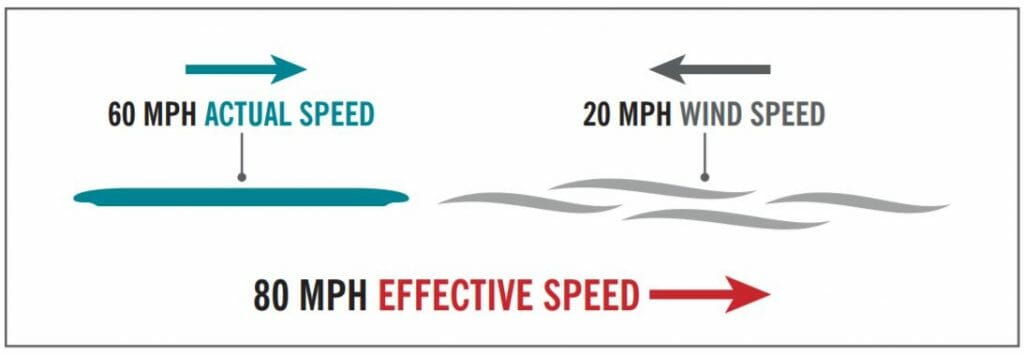
For this reason, overstable discs are especially important when throwing directly into a heavy headwind. Some of my favorite way-overstable discs are:
- Driver: Discraft Nuke OS Z-Plastic
- Midrange: Discraft Drone ESP FLX plastic
- Putter (for throwing, not putting): Discraft Zone ESP Plastic
A tailwind, on the other hand, will slow down the effective speed of your disc and cause an understable disc to fly with more overstable characteristics, including a reduction in glide (Figure 1.2). The recommendation, therefore, is to “disc down” when throwing into a tailwind (i.e., throw a less stable and lower speed disc, and, if possible, one with more glide, than you otherwise would).
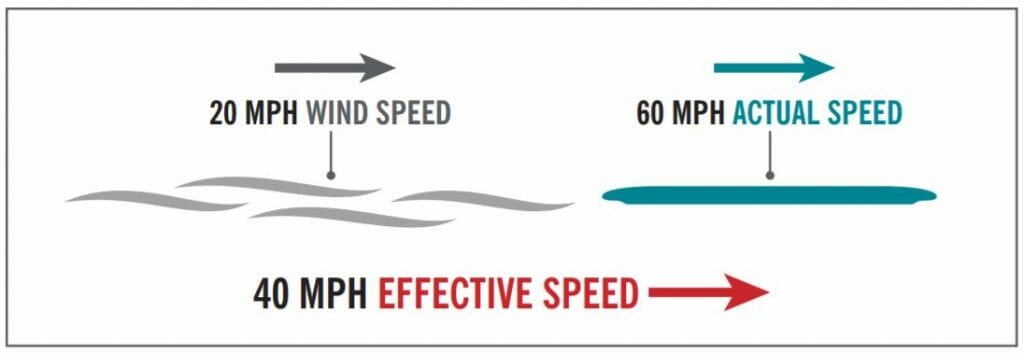
Shot Selection
In addition to disc stability, you should try to anticipate how the wind will push your disc when making your shot selection. In general, a disc thrown low, hard, and flat (i.e., neither hyzer or anhyzer) will be least affected by the wind because wind speeds tend to increase with height above the ground; fast-flying discs have greater momentum with which to resist the effect of the wind; and a flat-flying disc is maximally aerodynamic. But, unfortunately, we are not always at liberty to throw our discs low, hard, and flat. We often need to elevate our shots in order to clear obstacles; angle our discs to turn a corner; or throw a delicate shot to avoid hazards located behind the target. Thus, it is crucial that we understand the impact of the wind on discs traveling at various angles and speeds.
If there is one principle to keep in mind when selecting a shot in windy conditions, it is that the disc will be pushed upwards when the bottom of the flight plate is exposed to the wind and it will be pushed downwards when the top plate of the disc is exposed to the wind (Figure 2.1). So, for example, a shot thrown nose-down into a headwind is likely to get pushed directly into the ground, while a shot thrown nose-up will get pushed skyward (it will also get slowed down, resulting in a hard fade that will — for RHBH throwers — start your disc backwards and to the left).
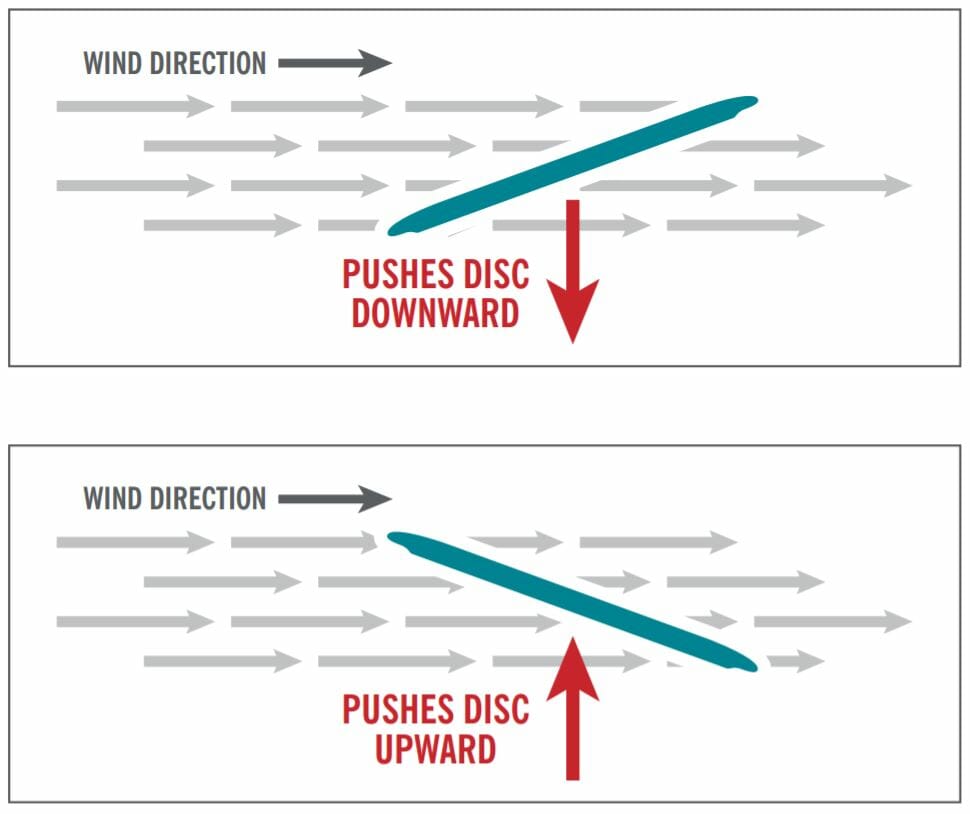
Crosswinds can also significantly impact the flight of the disc, especially when the top or bottom of the flight plate is exposed to the wind. Say, for example, you are on a hole with a wide-open fairway save for an obstacle directly in the middle. This forces a RHBH thrower to go wide-right with a hyzer or wide-left with an anhyzer. Also envision that you need a decent skip finish to your shot in order to reach the pin.
In this scenario, the direction of the crosswind should be an important consideration in your shot selection. If the wind is blowing right to left, then a RHBH player can use the wind to their advantage by throwing wide-right on a hyzer angle, and letting the wind carry and push the disc back to the left (Figure 3.1). Be careful when throwing this shot, however, as a disc that is thrown too high with its bottom plate exposed to the wind is likely to get caught up and sail — with potentially disastrous results.
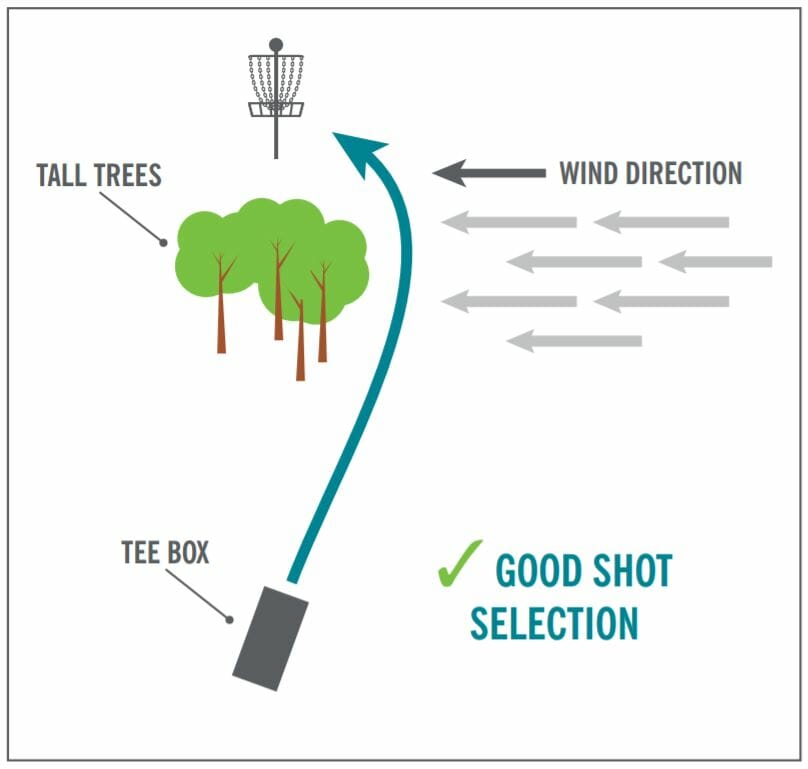
We can also describe the kind of shot that should be avoided in these particular conditions (a right-to-left crosswind). If your shot of choice on this hole is usually a RHBH anhyzer that starts wide-left and then finishes towards the right (or a RHFH/LHBH hyzer shot thrown along the same line), the trouble with throwing this shot in a right-to-left cross-wind is that the disc’s top plate will be exposed to the wind, pushing the disc toward the ground and limiting the overall distance of the shot — as well as preventing a skip finish to the right (Figure 3.2). This is not to say that this line cannot be successfully thrown in these conditions, but only that the difficulty becomes greater. Crosswind scenarios such as this one highlight the benefit of being able to throw both forehands and backhands because it affords the advantage of selecting a shot that is appropriate to the wind conditions on the course.
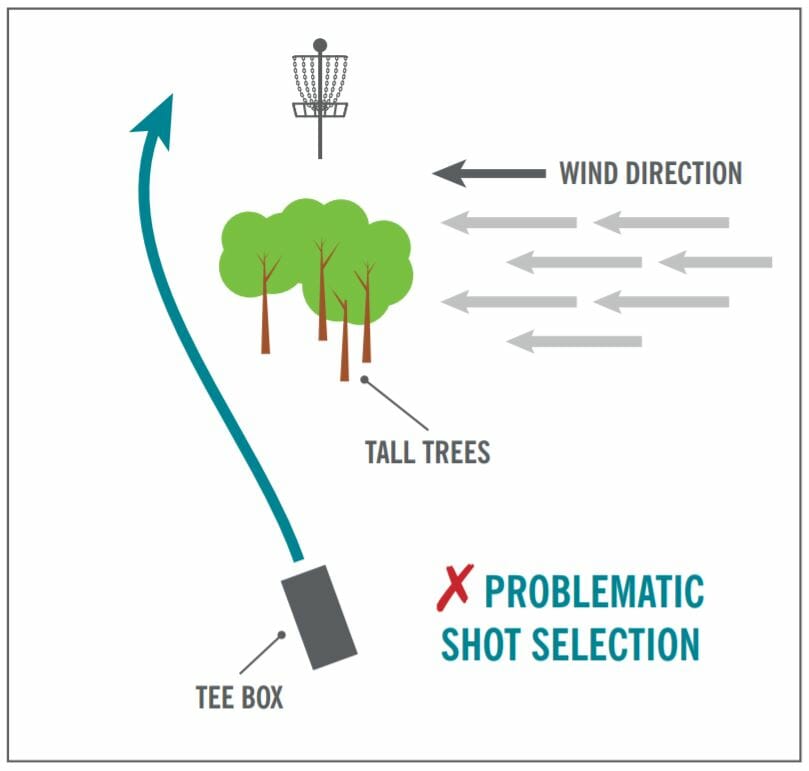
Some Final Thoughts
Windy conditions can present some of the greatest challenges one is likely to face on a disc golf course. Knowing how the wind is likely to impact the flight of your disc will help you attack the course by selecting discs and shots that can turn the wind from a liability into an asset. Add variety to your game so that you have options on the course to combat the wind. Pay attention to the wind throughout the round (don’t assume that the wind will always be blowing in the same direction) and make sure to evaluate the course for OB and hazards that will inform you when it is safe to be aggressive, and when one is better served with a conservative approach. More than anything, continue to have fun and learn to enjoy the unique challenge of discin’ in the wind!